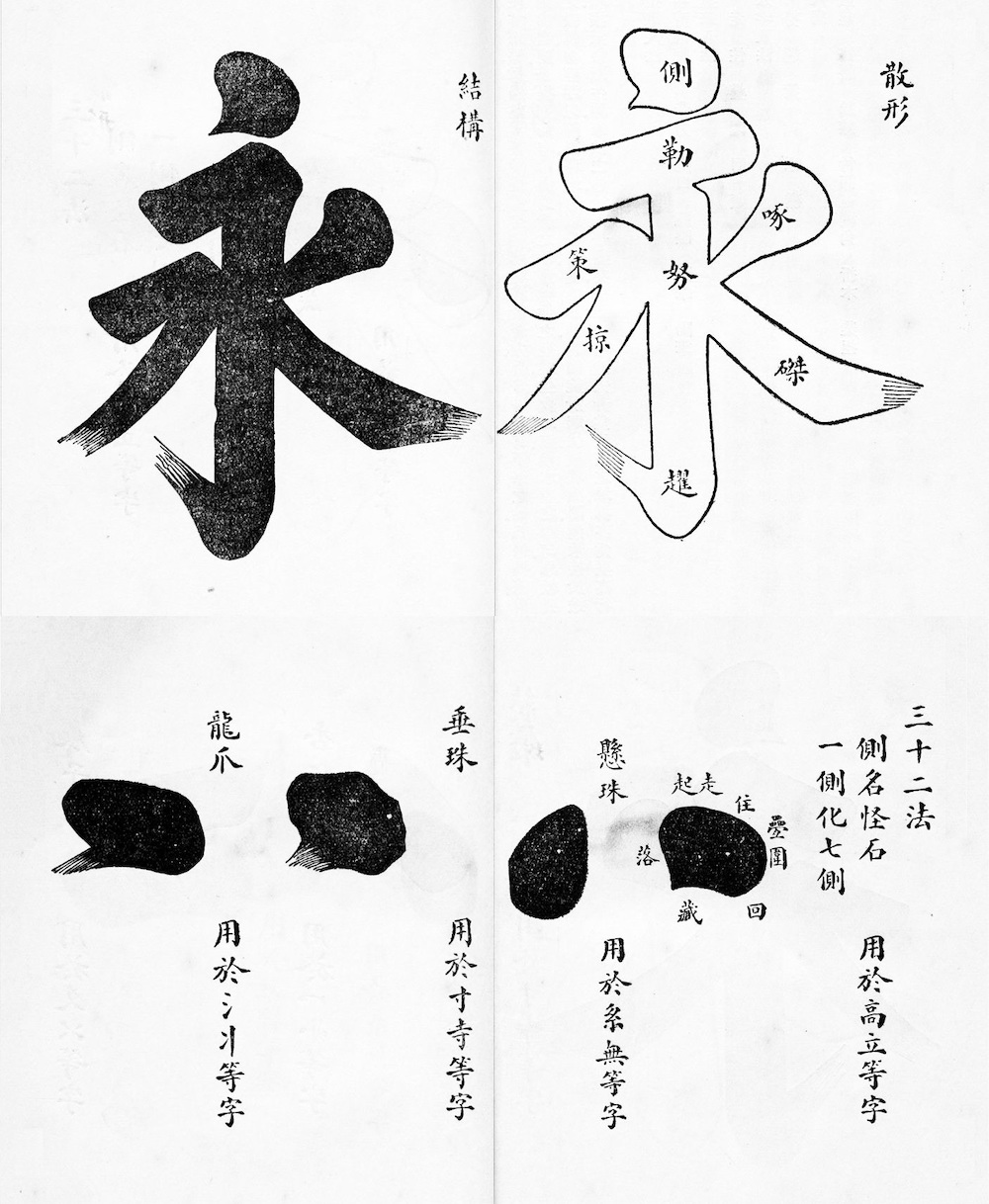There are two books on calligraphy with the title Shufa zhengzhuan 書法正傳 "The right transmission of the method of writing", one — more critical — written by Feng Wu 馮武, and one by Jiang He 蔣和. To tell them apart, Jiang's book is also known as Shufa zhengzong 書法正宗 or Jiangshi shufa zhengzhuan 蔣氏書法正傳.
Feng Wu 馮武 (b. 1627), courtesy name Doubo 竇伯, style Jianyuan 簡緣, hailed from Changshu 常熟, Jiangsu. His collected works are called Yaozhi ji 遙擲集. Feng's book on calligraphy was planned as an introduction to the art of calligraphy, a type of book that did not exist until that time. According to traditional custom, Feng did not compose a text of his own, but made use of older literature, statements of which he assembled appropriately.
The first four fascicles deal with techniques of calligraphy and quote from Chen Zezeng's 陳繹曾 (fl. 1329) Hanlin yaojue 翰林要訣 from the Yuan period 元 (1279-1368), the anonymous text Shufa sanmei 書法三昧, Li Puguang's 李溥光 demonstration of brush strokes Yong zi ba fa 「永」字八法, and Li Chunjin's 李淳進 "eighty-four methods", Da zi jiegou bashi fa 大字結構八十四法, from the Ming period 明 (1368-1644). The fascicles 5-7 (titled Zuanyan 纂言) focus on the theory of calligraphy and likewise quote from old writings. Chapters 8 and 9 present brief biographies of famous calligraphers and discuss the transmission of famous artworks. The last of the 10 fascicles (juan) is a product of Feng Wu himself (or of his uncle, Feng Ban 馮班, 1602-1671), who presents his interpretation of essential points in calligraphy.
 |
Top: Total appearance or "structure" (jiegou 結構), and eight individual strokes (sanxing 散形) with technical designations. Bottom: "Dot" (ce 側), its production in several steps, and various shapes (with a total of seven) as used in different characters, like the "suspending pearl" (chuizhu 垂珠) in 寸 and 寺 or the "dragon claw" (longzhua 龍爪) as in the character parts 氵 and 丬. From the Wanyou wenku 萬有文庫 edition. |
Feng Wu's book is included in the series Siku quanshu 四庫全書 and Guoxue jiben congshu 國學基本叢書. A first modern print was published in 1937 by the Shijie Shuju 世界書局. In 1983, the Zhongguo Shudian 中國書店 published a facsimile edition, while the Shanghai Shuhua Chubanshe 上海書畫出版社 published in 1985 a modern, type-setting edition.
| 1. | 翰林要訣 | Important formulas from the calligraphy forest (Chen Zezeng 陳繹曾) |
| 2. | 書法三昧 | Three secrets of calligraphy |
| 3. | 「永」字八法 | Eight strokes of the character yong (Li Puguang 李溥光) |
| 4. | 大字結構八十四法 | 84 methods for the structure of large characters (Li Chunjin 李淳進) |
| 5.-7. | 纂言 | Compiled words |
| 8. | 書家小傳 | Brief biographies of calligraphers |
| 9. | 名蹟源流 | The transmission of famous artworks |
| 10. | 鈍吟書要 | Dunyin shuyao "Important facts about calligraphy of [the Studio of] Dull Poetry" |
Jiang He 蔣和, courtesy name Zhongshu 仲叔, style Zuifeng 醉峰 or Xiaozhuo 小拙, hailed from Wuxi 無錫, Jiangsu. Jiang was an expert in seal script and chancery script. He participated in the compilation of the Siku quanshu and was in 1786 appointed academic instructor (xuezheng 學正) of the Directorate of Education (guozijian 國子監). Jiang wrote quite a few books on the Chinese script and its artistic applications, like Shuowen ziyuan jizhu 説文字原集注, Hanbei liti juyao 漢碑隸體舉要, Xuehua zalun 學畫雜論 and Xueshu zalun 學書雜論, Xiezhu zaji 寫竹雜記 or Jiangshi youyi milu 蔣氏游藝秘錄.
His Shufa zhengzhuan was first printed in 1779 and reprinted in 1876 by the Dajing Hall 大經堂 and in 1885 by the Shancheng Hall 善成堂 in Beijing. It is divided into four parts, in the first of which (Bifa jingjie 筆法精解) the movements of the brush are explained. The second part (Bihua quantu 筆畫全圖) is dedicated to the composition of a whole calligraphed text and the realisation of specific details with the help of particular brush movements and strokes. Part 3 (Fenbu peihe fa 分部配合法) provides details on the realization of character parts, while the last chapter, Quanzi jiegou juli 全字結構舉例, highlights issues of character composition.
Right at the beginning of the book, some basic introductions into calligraphy and painting are inserted, namely Zhang Xu's 張旭 (c. 675-c.750) famous calligraphy of the character yong 永 with eight exemplary brush strokes (Yong zi ba fa 永字八法), and the "Rules for the five skills of the painter" (Wu hua guize 五畫軌則), as well as "Brush methods transmitted from old times" (Gujin chuanshou bifa 古今傳授筆法), and Kangli Zishan's 康里子山 (Kangli Naonao 康里巎巎, 1295-1345) "Nine lively methods" (Jiushengfa 九生法) from the Yuan period.
Seen from the content, Jiang's book is very similar to that of Feng Wu, but it has more of the character of a textbook or instructions for performers of arts in their beginnings.